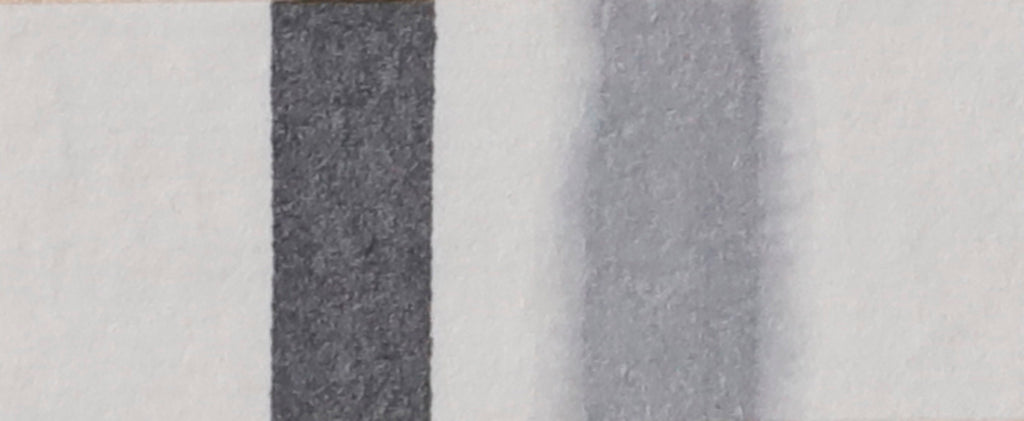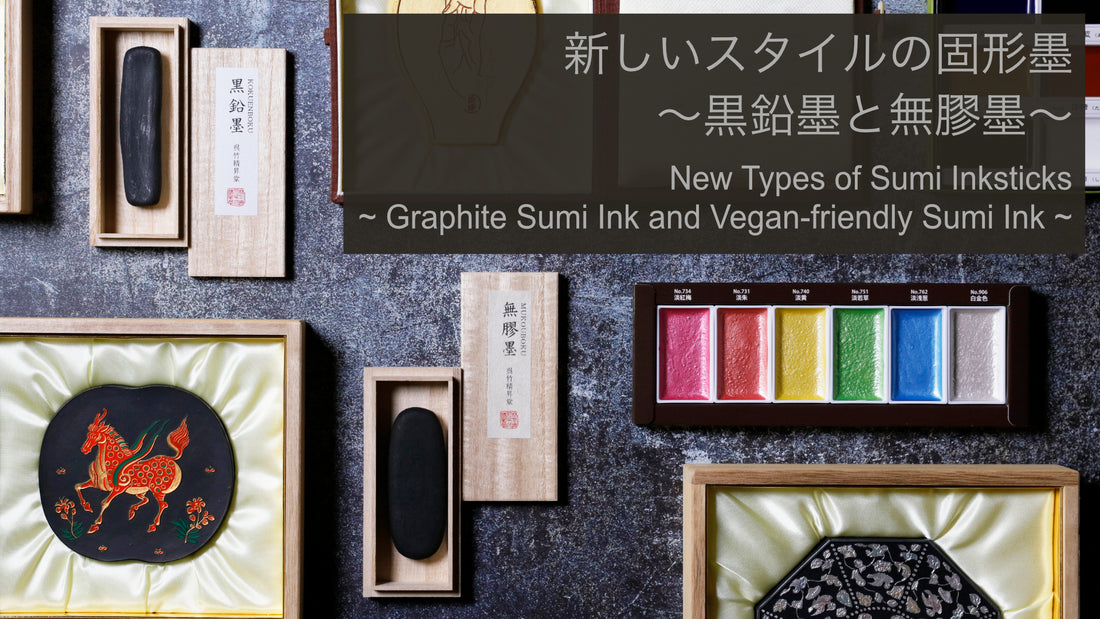We are pleased to announce the pre-sale of two new Kuretake ink sticks, Mukouboku (Animal-Free Ink Stick) and Kokuenboku (Graphite Ink Stick), available exclusively at PIGMENT TOKYO as of May 30, 2023.
Kokuen-boku (黒鉛墨)
Sumi ink is generally made by kneading soot from burned oil or wood with animal glue, however, these two new products come with different characteristics from conventional Sumi ink.
In this article, I interviewed Mr. Morihiro Noda, who works for product development at Kuretake Co., about these new inksticks and the story behind their production.
ーHow did you come up with using graphite to create Kokuen-boku?
Morihiro Noda (hereafter referred to as "Noda"): The history of Sumi ink goes back to the B.C. era, and I have always been interested in what the first Sumi ink was like. I worked for an ink manufacturer and designed various products but this question has always stayed in my mind.

Mr. Morihiro Noda from the production department of Kuretake Co.
ーI imagine it was not exactly the same as it is today.
Noda: The Kanji character for "Sumi (墨)" is ideographic and pictophonetic, so it indicates meaning and sound. If we look in detail, the upper part, “黒” represents smoke and clogged soot which also suggests a flame underneath them. The lower part “土” is believed to be a pictorial representation of soil hardened into a column shape to worship the gods of the land.
I find the meaning and use of “土” very inspiring and the idea of making Sumi ink with soil-based pigments and graphite came to my mind.
Graphite is a familiar material as pencils and Conté crayons, so I wondered if there is a possibility that people in the past used it for making inksticks instead of soot.
ーHow is it different from the soot used for usual Sumi inksticks?
Noda: Although the soot and graphite used in Sumi ink production have the same chemical symbol, C (stands for carbon), they have different crystal structures. Therefore, graphite has a slightly dull black color with grayish tints compared to soot.
Graphite powder
ーWhat′s your thoughts after making the prototype?
Noda: As I mentioned earlier, the key concept for making this Sumi ink is "What was the ancient Sumi ink like?"
However, the prototype I made was quite difficult to write with, and I could not control the flow with the brush as well. So I thought, "Perhaps after all, inksticks were made only with soot from the beginning," and kept it inside the desk in my office without asking other people to evaluate it.
And this was 15 or 16 years ago.
ーThen, why did you decide to make it as a product at this time?
Noda: Although I often visit the Kyoto University of the Arts (former Kyoto University of Art and Design), one day, I had a conversation with Professor Yoshiaki Aoki and we talk about if there’s any good way to use graphite powder since it spreads out in the air.
At that moment, the prototype of graphite Sumi ink that I had made before popped into my mind. From that on, I presented several prototypes to him and made improvements from there to create what we have right now, the graphite Sumi ink, Kokuen-boku.

A color sample of Kokuen-boku (Included in a package with the product)
ーI agree that graphite powder is difficult to handle.
Noda: In a sense, the pigment dispersant technique was applied to Sumi ink production in the very beginning. Our company has developed Sumi-making techniques for more than 120 years and built knowledge that can produce more than 100 colors of Gansai (Japanese traditional watercolors). We consider Sumi ink not just a part of stationeries but as an art material.
I believe the reason we could manufacture this Kokuen-boku now is that we had enough experience and techniques to bring the request from professors and students who use these materials out to reality.
ーWas the Mukou-boku also created in response to your customers?
Noda: Exactly. Most recently, a monk serving at a temple asked us, "Do you have any Sumi ink for sutra copying that is cruelty-free?" However, as you know, the only ingredients of Sumi ink are soot, animal glue, water and incense. Of course, Sumi ink can be made without adding incense, so the only essential ingredients are soot and animal glue.
More than 1500 years ago, during the Three Kingdoms period in China (184 - 280 AC), a person named Wei Duan (韋誕) wrote in the script titled "Bokukei (墨経)" that the ingredients of Sumi ink are soot and animal glue. In other words, although it may not apply to every inksticks, the formula of using soot and animal glue has been unchanged from more than 1000 years ago to the present day.
It has been more than 40 years since I was assigned to the technical development department, and during that time, I have received various questions and inquiries from people inside and outside the company. Some questions were unexpected, such as "Is there any Sumi ink that does not contain animal glue?"
ーThat sounds like an impossible request.
Noda: Exactly and so, like many other senior members in the department, my answer to that question was, "Although we have considered various options, inksticks cannot be made with any binder other than animal glue."
Even though I have still been asked this kind of question several times from now and then.
Needless to say, my colleagues and I have challenged ourselves to create a “Sumi ink without animal glue,” but we always failed.
| People Also Read The Basic Knowledge of Sumi Ink presented by the PIGMENT TOKYO chief Iwaizumi |
ーWhat challenges did you face in order to make this product?
Noda: When considering alternatives to animal glue, there are about ten key criteria that need to be fulfilled.
First, the binder must be able to coat the soot's particles stably, and next, it is important to be water-soluble. Otherwise, it is useless as a solid inkstick and cannot even be manufactured.
Moreover, it requires solidifying as it dries, stability to keep the quality for at least ten years, softening by warming it up and solidifying by cooling it down and redissolving by grinding on an inkstone at room temperature. Inksticks are dried in a wooden mold, so temperature reversibility is necessary in order to harden Sumi ink.
Furthermore, the alternative is required to allow the ink to be framed or mounted after drawing, to keep the Sumi ink color as black as possible even after time, to prevent damage to the brush and inkstone, and also to keep it safe for the human body and the environment.
ーIn other words, animal glue is almost irreplaceable.
Noda: Sumi ink made with animal glue fulfills all the above characteristics and since it is an incredibly unique adhesive it is used not only in making Sumi inksticks but also used as a material in paintings and art-making. In fact, more than 100 years ago, another company made a Sumi ink using vegan glue called "Kusa-nikawa (草膠)". However, it is believed that it was not for general distribution and was treated as a kind of rare product.
After reading some references, I figured out that the resin used for this "Kusa-nikawa," and I even made a prototype decades ago using a resin with a similar composition, although it still did not meet some of the criteria I mentioned earlier.

A part of animal glue displayed at PIGMENT TOKYO
ーWhat made you decide to produce it as a product?
Noda: After more than 40 years in the company, I was able to take some time off from my busy schedule to figure some ideas out. Through conversations with people in various fields over these years, I realized that certain customers are looking for Sumi ink that does not contain animals.
Once again, we have organized many prototypes we made in the past with the technical experience and knowledge we have today, we’re able to create this vegan-friendly Mukou-boku.
With this new creation, we’re not here to repudiate the 1,000 years-long histories of Sumi ink that are made with animal glue but simply want to present it as an alternative option.
ー In the meantime, are we allowed to ask what kind of glue is used here?
Noda: Unfortunately, it is a trade secret and I have to keep it confidential.
The only thing I can tell you now is that it meets all of the ten criteria I mentioned previously, even though there are varying degrees of qualification.

A color sample of Mukou-boku (Included in a package with the product)
Even today, animal glue is a functional and excellent adhesive that is hard to find an alternative. However, since it is derived from animal skins and bones, some people try to avoid using it.
Surprisingly, the company has been able to solve this problem with the technology and knowledge they have developed since 1902.
Last but not least, these two new Sumi inksticks are perfect for PIGMENT TOKYO as we are long inspired by the concept of “A Traditional Art Materials Lab for Creating the Now,” since it motivates us to think outside of the box that “Sumi ink must be made with animal glue” and create a new tradition.
These products are now available for our customers to try out in-store. Therefore, feel free to check out our new Kokuen-boku (graphite ink) and Mukou-boku (vegan-friendly ink) during your next visit to PIGMENT TOKYO.
Translated by Atsumi Okano and Nelson Hor Ee Herng
PIGMENT TOKYO Art Materials Experts


